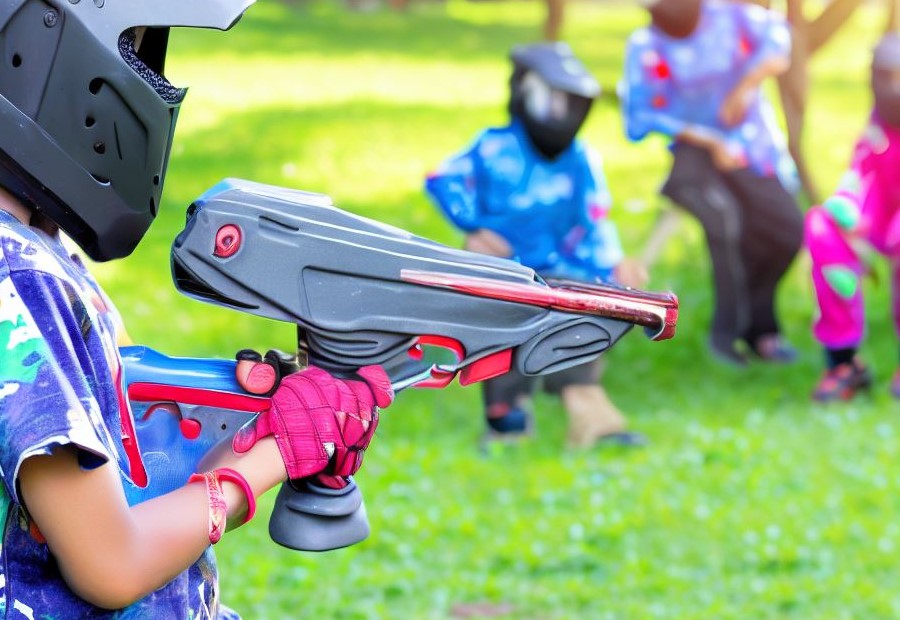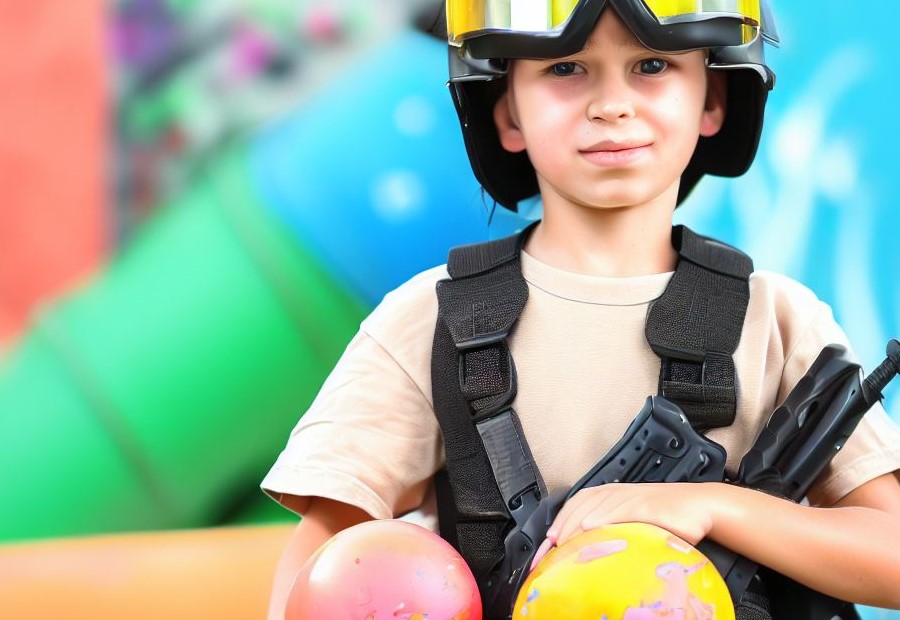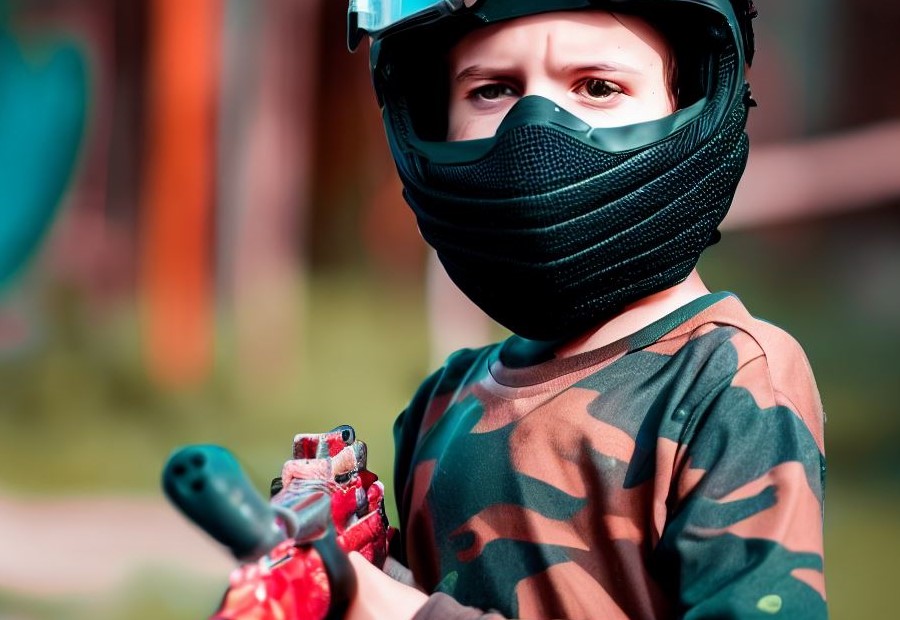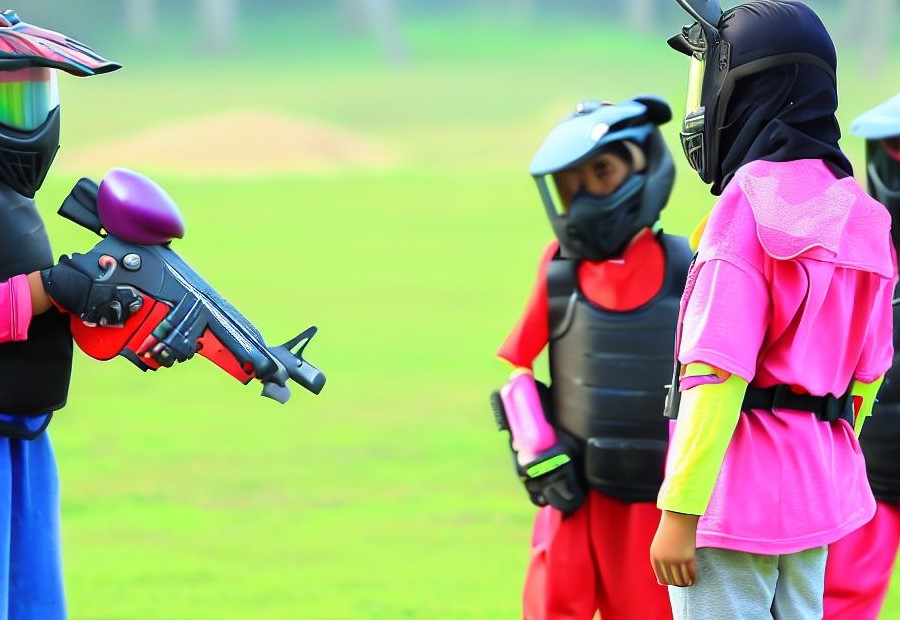Paintball is a popular recreational activity that involves players shooting each other with paint-filled pellets using air-powered guns. While paintball can be an exciting and enjoyable experience for kids, safety is of utmost importance. Understanding the basics of paintball and its safety considerations is crucial. According to the International Paintball Association, paintball is generally safe for kids when certain precautions and guidelines are followed.
Paintball is essentially a game where players eliminate opponents by tagging them with paint-filled pellets. The game can be played in various formats, including capturing the flag or eliminating all players on the opposing team.
While safety in paintball for kids is a paramount consideration, participating in paintball can provide several benefits for kids. These benefits include physical fitness and exercise, teamwork and communication skills, and the development of strategy and problem-solving abilities.
Despite the safety measures in place, there are still potential risks and safety concerns associated with paintball. These include impact and bruising from paintball hits, eye, and facial injuries, as well as allergic reactions to paintballs. Mitigating these risks requires proper safety gear, adherence to rules, and regular check-ups of equipment.
To ensure a safe paintball experience for kids, it is essential to choose reputable and reliable paintball facilities, provide proper training and education, emphasize and enforce safety rules, and regularly inspect and maintain equipment.
By considering these factors and prioritizing safety at all times, parents and guardians can assess the suitability of paintball for their children and provide a safe and enjoyable experience for them.
The Basics of Paintball

- Objective: The objective of paintball is to eliminate opposing players by tagging them with paint-filled gelatin capsules using paintball markers.
- Equipment: Players wear protective gear, including goggles or masks to protect their eyes and face from paintball impacts. They also use paintball markers, which are air-powered guns that shoot paintballs.
- Gameplay: Paintball games can be played in various formats, such as capture the flag, elimination, or scenario games. Players strategize, communicate, and work together as a team to achieve the game objectives.
- Safety: Safety is a crucial aspect of paintball. Players must follow strict safety rules, including wearing proper protective equipment, never removing their goggles during the game, and adhering to field guidelines and rules.
- Locations: Paintball games are typically played in designated paintball fields that provide a controlled and safe environment for players. These fields may have natural or artificial obstacles for players to seek cover and plan their strategies.
- Skill Development: Paintball requires physical agility, teamwork, communication, and strategic thinking. Playing paintball can enhance these skills and provide an exciting and challenging outdoor activity.
Is Paintball Safe for Kids?

Looking to find out if paintball is safe for kids? In this section, we’ll dive into the various factors that determine the safety of paintball for children. From age restrictions and guidelines to the importance of protective gear and equipment, as well as supervision and safety measures, we’ll cover it all. Plus, we’ll explore the importance of game rules and fair play in ensuring a secure and enjoyable paintball experience for kids. So let’s get right into it!
Age Restrictions and Guidelines
When it comes to paintball, age restrictions and guidelines are important to ensure the safety and enjoyment of kids participating in the activity. The table below outlines the age restrictions and guidelines for paintball:
| Age Group | Restrictions and Guidelines |
| 5-8 years old | Not recommended for this age group due to the potential for injury. |
| 9-12 years old | Can participate in low-impact paintball games designed specifically for kids in this age group. These games use smaller, lighter paintballs and equipment to reduce the impact and minimize the risk of injury. |
| 13-17 years old | Can participate in regular paintball games but should be supervised by adults and adhere to safety rules and regulations. Protective gear, including masks, should be worn at all times. |
It’s important to note that these age restrictions and guidelines may vary slightly depending on the paintball facility and the specific rules they have in place. It is always recommended to check with the facility beforehand to ensure compliance with their regulations.
When considering paintball for kids, safety should always be the top priority. By following age restrictions and guidelines and providing adequate supervision and protective gear, kids can safely enjoy the excitement and fun of paintball.
Protective Gear and Equipment
Ensuring the safety of kids while playing paintball requires the use of protective gear and equipment. Goggles, which fit properly and meet industry safety standards, are essential for protecting the eyes and face from direct hits and potential injuries. Additionally, a paintball mask provides extra protection to sensitive areas like the nose, mouth, and ears. It is important to choose a mask that fits securely and comfortably.
Wearing long-sleeved shirts, pants, and jackets made of thick material can help minimize the impact of paintballs. Look for clothing specifically designed for paintball that offers padding and protection. Protective gloves are also important to protect the hands and fingers from painful hits and potential injuries. It is advisable to choose gloves that offer enough dexterity to grip the paintball marker effectively.
When it comes to footwear, sturdy closed-toe shoes or boots with good traction are crucial to prevent slips and falls during the game. It is important to avoid wearing sandals or open-toed shoes to ensure maximum safety.
Supervision and Safety Measures
Supervision and safety measures are of utmost importance when it comes to ensuring a safe paintball experience for kids. These key measures should be incorporated:
- Always ensure adult supervision is present: It is crucial to have responsible adults overseeing the game at all times to guarantee the children’s safety.
- Enforce the use of protective gear: It is essential for kids to be equipped with proper protective gear, such as masks, goggles, and padding, in order to minimize the risk of injuries.
- Establish safety zones: Designate specific areas on the field where players can safely remove their masks or take breaks from the game, thus preventing accidents.
- Teach and enforce safety rules: Prior to participating, ensure that children are familiar with the game’s rules and safety protocols, such as not removing their masks during gameplay or aiming for the head or face.
- Regularly inspect and maintain equipment: Perform regular checks on paintball markers and other equipment to ensure they are in optimum condition and functioning properly.
By implementing these supervision and safety measures, parents and organizers can create a secure environment for kids to enjoy the excitement of paintball while minimizing potential risks.
Game Rules and Fair Play
When it comes to paintball, game rules and fair play are essential to ensure a safe and enjoyable experience for everyone involved. Here are some important aspects to consider:
- Always follow the game rules set by the paintball facility. These rules are in place to promote fairness and safety.
- Respect the boundaries and areas designated for gameplay. Stay within these boundaries to avoid any disputes or potential accidents.
- Avoid overshooting or shooting at players who have already been eliminated or have signaled that they are out. This is considered poor sportsmanship and can lead to unnecessary injuries.
- Communicate with your teammates during the game to strategize and coordinate your moves. Clear and effective communication can help improve teamwork and ensure fair play.
- If you accidentally break a rule or hit a player who is already out, acknowledge your mistake and apologize. Being honest and accountable for your actions is an important part of fair play.
Pro-tip: Remember, fair play is not just about following the rules – it’s also about being respectful, courteous, and considerate towards your fellow players. Embrace the competitive spirit of the game while maintaining good sportsmanship at all times.
Benefits of Paintball for Kids

Paintball is an activity that incorporates various benefits for kids. Firstly, it promotes physical activity and exercise, involving running, dodging, and shooting, which greatly improves their coordination and overall fitness levels.
Additionally, paintball encourages teamwork and effective communication among team members, as kids learn to work together, strategize, and communicate to achieve common goals. Moreover, it challenges them to think quickly and develop effective strategies to outsmart their opponents, enhancing their problem-solving skills and decision-making abilities.
Successfully completing objectives and working as a team in paintball can also boost kids’ self-confidence, providing them with a sense of accomplishment and belief in their abilities. Furthermore, paintball acts as a stress reliever for kids, providing an adrenaline rush and an opportunity to release their energy, resulting in reduced stress and a sense of well-being.
It also creates a social environment where kids can interact with peers and make new friends, fostering socialization and the development of interpersonal skills. Above all, paintball is a fun and exciting activity for kids, offering an element of thrill and adventure, ensuring an enjoyable experience.
Potential Risks and Safety Concerns

Photo Credits: Paintballbuzz.Com by Logan Green
Paintball can be a thrilling activity for kids, but it’s essential to consider the potential risks and safety concerns involved. In this section, we’ll dive into the gritty details and uncover the facts behind impact and bruising, eye and facial injuries, as well as allergic reactions to paintballs. Hold onto your seats as we explore the dark side of this adrenaline-fueled game, backed by real-life incidents and expert opinions. It’s time to separate the myths from the truths and ensure a safe paintball experience for your little warriors.
Impact and Bruising
Paintball can sometimes result in impact and bruising incidents, making it important to assess the safety of the sport for kids. It is crucial to note that while paintballs are designed to burst upon impact, they can still cause discomfort and leave temporary marks on the skin. However, these bruises and marks are typically minor and will fade within a few days.
To mitigate the risk of impact and bruising, it is essential to ensure that kids wear appropriate protective gear, including padded clothing and facemasks, while playing paintball. Such gear helps absorb the impact of the paintballs, reducing the likelihood and severity of bruises.
Additionally, the velocity at which the paintball marker shoots the paintballs can affect the force of impact. Ensuring that the velocity is within safe limits, as recommended by paintball facilities or organizations, is crucial to minimizing bruises and injuries.
Supervision and adherence to safety rules are also paramount in preventing excessive impact and bruising during paintball games. Proper training and education on game rules, fair play, and safe shooting distances can help reduce the risk of players being hit with excessive force.
By implementing these safety measures, parents and guardians can provide a safe paintball experience for kids, significantly reducing the likelihood and severity of impact and bruising incidents.
Eye and Facial Injuries
Eye and facial injuries are potential risks associated with paintball. Direct hits to the eye can cause severe damage, including corneal abrasions, retinal detachment, and vision loss. Paintballs traveling at high speeds can also cause injuries to the face, such as bruising, cuts, and fractures.
Protective gear, such as goggles or masks specifically designed for paintball, should always be worn to reduce the risk of eye and facial injuries. Failing to wear proper protective gear or removing it during gameplay significantly increases the likelihood of sustaining injuries.
It is essential to ensure that the protective gear fits properly and is in good condition. Regularly inspecting and maintaining the equipment can help prevent malfunctions that could lead to accidents and injuries. Supervision is crucial to ensure that players follow safety rules and guidelines to minimize the risk of injuries. Proper training and education on safety protocols and techniques can also help prevent accidents.
Ensuring a safe paintball experience for kids requires a combination of proper protective gear, supervision, and adherence to safety rules. By implementing these measures, parents can help ensure a safe and enjoyable paintball experience for their kids.
Allergic Reactions to Paintballs
Paintball players, including kids, may experience allergic reactions to paintballs. Allergic reactions occur when the body’s immune system reacts to substances it perceives as harmful. Some individuals may develop allergic reactions to the components of paintballs, such as the liquid fill or the shell material. These reactions can range from mild to severe, depending on the individual’s sensitivity and the specific allergen involved.
Common symptoms of allergic reactions to paintballs may include itching, redness, swelling, hives, and in severe cases, difficulty breathing or anaphylaxis. It is crucial for parents and guardians to be aware of these potential reactions and take precautions to prevent them.
To minimize the risk of allergic reactions to paintballs, it is recommended to:
- Check the ingredients: Before using any paintball brand, carefully read the label or packaging for information on the components used in their production.
- Conduct a patch test: Perform a patch test by applying a small amount of paintball liquid or gel on the child’s skin and observing for any adverse reactions before engaging in a full game.
- Wear protective gear: Ensure children wear appropriate protective gear, including face masks, goggles, and gloves, to minimize direct contact with paintball substances.
- Seek medical advice: If a child has a known allergy to certain substances or has experienced previous allergic reactions, it is advisable to consult a healthcare professional before participating in paintball activities.
By following these precautions and being vigilant, parents can help ensure a safe and enjoyable paintball experience for their kids while minimizing the risk of allergic reactions to paintballs.
Tips for Ensuring a Safe Paintball Experience for Kids

When it comes to paintball for kids, safety is of utmost importance. In this section, we will explore some valuable tips to ensure a safe and enjoyable paintball experience for your children. Discover how to select suitable paintball facilities, provide thorough training and education, emphasize the importance of safety rules, and maintain equipment regularly. By following these guidelines, you can guarantee a fun-filled adventure while keeping your little ones protected throughout their paintball journey.
Choose Appropriate Paintball Facilities
When ensuring a safe paintball experience for kids, it is crucial to prioritize the selection of appropriate paintball facilities. It is important to verify that the facility adheres to safety protocols and has adequate safety measures in place.
- Inspect the playing area: Before permitting your child to play, thoroughly examine the playing area for any potential hazards or dangerous obstacles. It is essential to ensure that the field is well-maintained, free from debris, and properly marked.
- Check for safety equipment: It is crucial to verify that the facility provides proper safety equipment, such as masks, goggles, and protective padding, for all participants. Moreover, the equipment should be in good condition and fit the children correctly.
- Review safety rules: It is advisable to select a facility that prioritizes and enforces safety rules. Make sure that the staff provides clear instructions on how to play safely, including guidelines on shooting distances and target zones.
- Trained staff: Opt for facilities that have trained staff members present during games. These individuals should possess knowledge about safety procedures, be capable of handling emergencies, and offer guidance to the children during gameplay.
- Age-appropriate games: It is integral to ensure that the facility offers games and activities that are suitable for the children’s age groups. Younger kids should not be exposed to games designed for older participants, as this may heighten the risk of accidents or injuries.
By selecting paintball facilities that prioritize safety, you can provide your child with a fun and enjoyable paintball experience while significantly reducing potential risks.
Provide Proper Training and Education
When it comes to ensuring a safe paintball experience for kids, providing proper training and education is essential.
- Training: It is crucial for kids to receive thorough training in order to properly handle and operate paintball equipment. They need to be well-versed in the rules of the game, safety protocols, and proper shooting techniques to minimize the risk of accidents.
- Education: Educating kids about the potential risks and safety concerns associated with paintball is of utmost importance. They should be aware of the impact and bruising that can occur from paintball hits, as well as the possibility of eye and facial injuries. It is also crucial to teach them about allergic reactions to paintballs.
- Supervision: To ensure the safety of children while playing paintball, they should always be supervised by a responsible adult. This ensures that safety rules are followed, and any emergencies can be quickly addressed.
- Communication: Effective communication plays a key role in providing proper training and education. Kids should be encouraged to ask questions and voice any concerns they may have about safety during paintball games.
- Reinforcement: Consistently reinforcing safety rules and proper training is important to ensure that kids understand and follow them every time they engage in a paintball activity.
By providing proper training and education, parents and instructors can help kids enjoy paintball while minimizing the risk of injuries and creating a safe environment for everyone involved.
Emphasize and Enforce Safety Rules
It is of utmost importance to emphasize and enforce safety rules in order to ensure a safe paintball experience for kids. Here are some vital safety rules that should be followed:
- Always prioritize wearing appropriate protective gear, including a paintball mask, padded clothing, and gloves.
- Under no circumstances should you ever remove your mask while on the field, even if the game is paused or you feel uncomfortable.
- Keep your finger off the trigger until you are fully prepared to shoot.
- It is crucial to always handle your paintball marker as if it is loaded, regardless of whether you believe it to be empty.
- Only direct your shots at authorized targets, such as opponents who are wearing designated safety gear.
- It is absolutely prohibited to intentionally shoot at close range or aim for someone’s face.
- Ensure that you consistently follow the game rules and adhere to the principles of fair play.
- Maintain good communication with your team and attentively listen to instructions provided by the field marshals.
Pro-tip: In addition to placing emphasis on safety rules, it is important to encourage open communication about safety concerns and remind kids to report any discomfort or injuries they may experience during the game.
Regularly Inspect and Maintain Equipment
Regularly inspecting and maintaining paintball equipment is crucial to ensure a safe playing experience for kids. Here are the steps to follow:
- Regularly inspect the paintball marker (gun) before each game to ensure it is in proper working condition.
- Regularly check for any cracks, leaks, or damage in the marker’s body, barrel, or hopper.
- Regularly clean the marker to remove dirt, debris, and paint residue that may impact its performance.
- Regularly inspect the air tank for any signs of damage or leaks. Ensure it is properly secured to the paintball marker.
- Regularly check the paintballs for signs of damage, swelling, or deformation. Discard any damaged or old paintballs.
- Regularly inspect the protective gear, including masks, goggles, and pads, before each game. Look for cracks, tears, or worn-out straps.
- Regularly clean and sanitize the protective gear after each use to prevent the spread of bacteria or germs.
- Regularly ensure that the masks fit properly and provide clear vision. Replace any fogged or damaged lenses.
- Regularly inspect the CO2 or compressed air tanks for damage or leaks. Make sure they are within the recommended pressure range.
- Regularly store all paintball equipment in a cool, dry place to prevent deterioration and damage.
By regularly inspecting and maintaining paintball equipment, you can minimize the risk of malfunctions or accidents during play and enhance the safety of the paintball experience for kids.
Frequently Asked Questions
How safe is paintball for kids?
Paintball is a safe sport for children, with a lower risk of injury compared to outdoor sports like football, soccer, and baseball. According to the U.S. Agency for Healthcare Research and Quality statistics, only 0.2 people out of every 100,000 get injured while playing paintball. Serious injuries are rare, occurring only in one out of every half a million players.
What is the age limit for paintball?
The age limit for regular paintball is typically 10-12 years old. However, there is a version called low-impact paintball specifically designed for younger children. This allows kids as young as 9 years old to participate and enjoy the sport.
Are there any inherent dangers in paintball?
While paintball is generally safe, some inherent dangers include the potential for bruising, skin lacerations, eye injuries, ear injuries, and sprained joints or fractured bones. However, these risks can be minimized by following safety precautions, using proper gear, and playing with children of similar age.
What are some important safety rules for kids playing paintball?
It is crucial for kids to follow safety rules such as always wearing a mask to protect the eyes, keeping the barrel cover on when off the field, raising the hand and yelling “HIT” when eliminated, avoiding jumping or climbing on the field, and not shooting anyone within a 15-foot radius. Additionally, paintball guns must not exceed a velocity of 280-300 FPS, and players must always look where they shoot to avoid accidents.
Is paintball suitable for birthday parties or weekend outings?
Absolutely! Paintballing can be a fun and active outdoor activity for kids’ birthday parties or weekend outings. Many paintball venues, such as PPK, offer paintball packages specifically designed for juniors, including protective gear and low-impact paintball guns. It provides an opportunity for kids to engage in team building, learn tactics, and have an exciting time in a safe environment.

